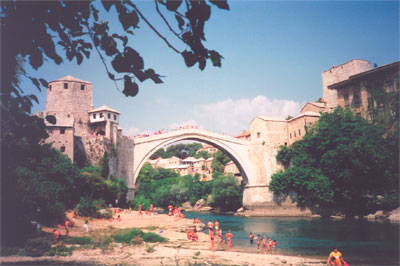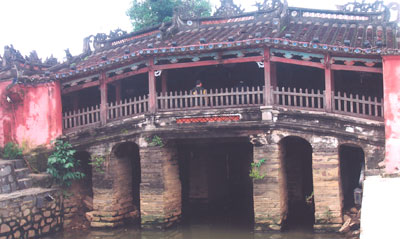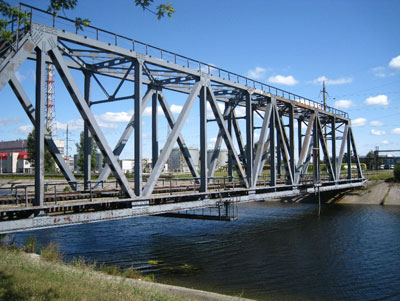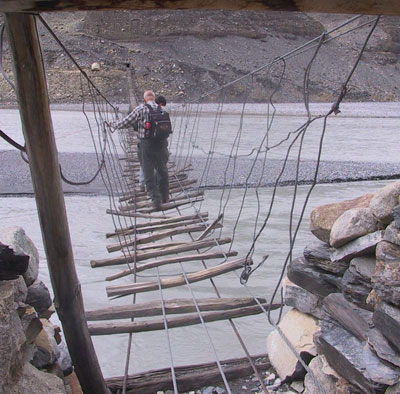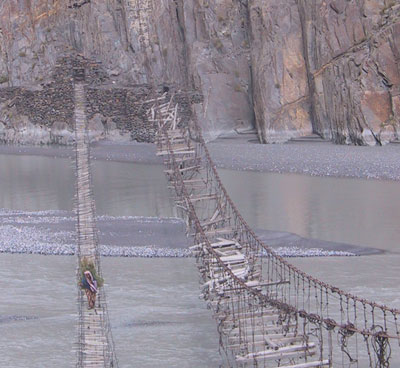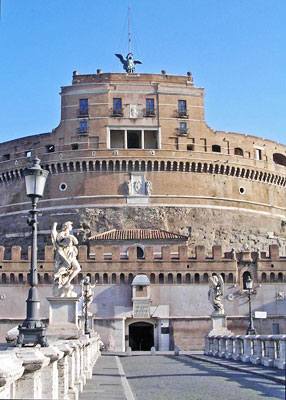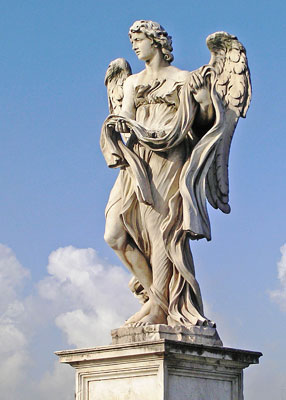Cross that bridge
We got a terrific response to the assignment we gave you a few months ago.
Name a bridge (outside of the USA) that, for whatever reasons, is exciting to cross. Whether it’s big or small, tell where it is (and, if necessary, how to find it) and approximately when you were there. Did you cross it on foot? By car? By train? Is it worth the trip because the bridge itself is impressive in some way or because of the view from the span? Include your impressions plus any personal encounters or experiences. Is there anything someone should remember to take along to better enjoy a visit to the bridge?
Following is some of the bridge work we received, with more to come. If you have something to add, write to Cross That Bridge, c/o ITN, 2116 28th St., Sacramento, CA 95818, or e-mail editor@intltravelnews.com (include the address at which you receive ITN). Send photos (with captions), if available.
My favorite bridge is the Steinerne Brücke, or Stone Bridge, in Regensburg, Germany. The bridge spans the Danube River and was completed in 1146. Over 100,000 Crusaders crossed the bridge on their way from Europe to the Middle East. I could picture the soldiers marching and riding on horseback across the bridge.
The bridge allows for both drivers and pedestrians. I walked across it during visits in December ’05 and ’07, and I believe it is best to explore the bridge on foot. However, there is a steep incline.
The bridge connects the Old and New towns. The Old Town contains the main shopping area, which is crowded during the Christmas season. When you cross the bridge to the New Town, the peace and quiet are welcome after the hustle and bustle of the Old Town’s markets.
Diane Harrison
Creve Coeur, MO
In the Netherlands Antilles, in the southern Caribbean, is Curaçao, founded in the 17th century and home to the 122-year-old Queen Emma Bridge. This pedestrian “swing bridge” floats on 16 pontoon boats. It connects two parts of the capital city of Willemstad: Punda (the main downtown area) and Otrobanda (meaning “the other side”).
Known as the Swinging Old Lady, it swings open using two motors to allow ships to access the large and busy port.
From 1901 to 1934, people had to pay a toll to cross unless they were barefoot, so, of course, many residents would remove their shoes upon approach.
If you’re on the bridge when a ship approaches, buzzers sound, lights flash and if you’re in a hurry you sprint for shore. If you’re at leisure, you ride the bridge as it swings open, then again when it closes.
We’ve traveled to Curaçao 12 times, most recently in 2005. I checked and in December ’09 the bridge was still operating.
Kent Shamblin
Beaver Bay, MN
Of all the bridges I have seen, the one that haunts me most is the curving, single-arch bridge over the River Neretva in Mostar in what was Yugoslavia when we visited in 1989 and what is Bosnia & Herzegovina today. It was built by the Turks in 1556. Mostar was the provincial capital of Herzegovina then, and both Christians and Moslems lived there in peace.
Our memories of Mostar are of magical mosques and minarets, bazaars and cobbled streets. The most vivid memory of all is the bridge.
Crossing it, walking up the gentle slope, turned out to be tricky. The marble walkway had been polished by thousands of feet over the centuries and it was slippery enough to force us to hold onto the sides. Most exciting was watching the young boys jumping from it into the swift green waters below.
The bridge was damaged extensively in 1993 during the Croat-Bosniak War, but it was carefully restored over a five-year period at a cost of $15 million and reopened on July 23, 2004.
Carl Haag
Princeton, NJ
The Japanese covered bridge in Hoi An, Vietnam, is a photo opportunity. Japanese settlers built it in the 16th century to allow easier access between the Japanese and Chinese communities.
I enjoyed crossing it (no cars allowed) in December ’08, when the weather in all of Vietnam was almost perfect. Easily found at one end of the shopping streets (at the west end of Tran Phu, the main street in Old Town), the colorful bridge has a tile roof, with a temple along one side.
Barbara McIntosh
Roseville, CA
The two most memorable bridges from my travels didn’t have names. Spanning the Hunza River in northeast Pakistan, near Gulmit, they were about as basic as it’s possible to get: steel cables with wooden slats pushed through the bottom at mismatched angles. I couldn’t reach both side cables on the first bridge so went over it with our guide, but I managed the second one solo.
After our little group of Westerners had made our slow progress across the second bridge, we looked back and saw a couple of local women, almost invisible under the bundles they carried, crossing as if they were on solid ground.
The Hunza Valley was spectacular. I was there in September ’01 and would love to go back, but the Taliban are a bit too close right now.
Kathy Wilhelm
Cary, NC
My travel companion Margaret and I visited the power plant at Chernobyl, Ukraine, in August ’09. There we saw a rail bridge, part of the rail network that was used to deliver construction materials to Units 5 and 6 and nuclear fuel to Units 1, 2, 3 and 4. We crossed the bridge on foot on our way to the sarcophagus of the infamous Unit 4.
The bridge, as with the nuclear facility and the evacuated city of Prypiat, is cold, lifeless and rusting away.
Life does exist there, however! If you have the opportunity to visit Chernobyl and cross this bridge, be sure to take a loaf of bread, as the truly giant catfish living in the canal below will be grateful.
Edwin Earl
Laguna Beach, CA
The Glienicke Bridge, a short span linking Berlin and Potsdam, Germany, could never be described as an imposing feat of engineering, nor does it offer a spectacular view. It had its moment of fame, however, when, on Feb. 10, 1962, American U2 pilot Francis Gary Powers, who had been shot down over the Soviet Union and held for 21 months on charges of spying, was brought to the bridge and exchanged for Soviet KGB Colonel Vilyam Fisher (aka Rudolf Abel).
I found it exciting, in September of 2000, to walk across the Glienicke and stand on the spot that marked the culmination of one of the most tense incidents of the Cold War.
Jane Hennegar
Baltimore, MD
Crossing the ancient bridge lined with a host of angels became, for me, an almost inspirational, religious experience. Silhouetted against an azure sky filled with white clouds, the angels carved in white stone seemed to morph into a homily on the Crucifixion, since each angel held an instrument of Christ’s Passion.
It was a sunny, spring day in April ’08 and I was on my own in Rome, trekking across the Eternal City from the Piazza Barberini to visit the Vatican Museums. As I walked along the Tiber River, I encountered the massive, towering cylindrical edifice now known as the Castel Sant’Angelo, built in antiquity as Hadrian’s tomb.
Next to it, also built by Hadrian in AD 134, was the Pons Aelius, now known as the Ponte Sant’Angelo, a bridge over the Tiber in three spans faced with travertine. It is only a pedestrian bridge today but is regarded as one of Rome’s most beautiful.
In 1669, Pope Clement IX commissioned Gian Lorenzo Bernini, the great Baroque architect and sculptor, to design a series of statues of angels to decorate the bridge. It was to be the artist’s last commission. Only two statues are believed to have been completed by Bernini, himself; students and associates finished the project. Both of Bernini’s angels are now in the church of Sant’Andrea delle Fratte in Rome, while copies were made for the bridge.
Bernini’s grand conception and his designs of the angels are what made crossing the bridge on foot such a memorable experience for me.
The contrapposto, or twisting poses of the figures, the swirling drapery, the often ecstatic facial expressions and the dramatic interplay of light and shadow over the deeply carved statues all contribute to the movement and drama of the figures carved in a High Baroque style.
As a sermon set in stone, the angels narrate the Crucifixion of Christ as they carry aloft such instruments of the Passion as the crown of thorns, the Sudarium (Veronica’s Veil), the Cross, the lance that pierced Christ’s side and the superscription (the angel holds a scroll with the initials “I.N.R.I.”).
The Ponte Sant’Angelo is easy to find. It is at the end of Via Banco S. Spirito and connects Lungotevere Castello on one side of the Tiber to Lungotevere Aloviti on the other.
It is also within easy walking distance (about half a mile) of another of Bernini’s great masterworks, the plaza in front of St. Peter’s in Vatican City, if the Via della Concilazione is followed out through the opening in the ellipse of the great plaza.
To escape the hordes of tourists thronging St. Peter’s and the piazza, I recommend that you visit the bridge of angels, where you can quietly contemplate and be exhilarated by seeing such a magnificent group of the heavenly host.
David J. Patten
Saint Petersburg, FL

